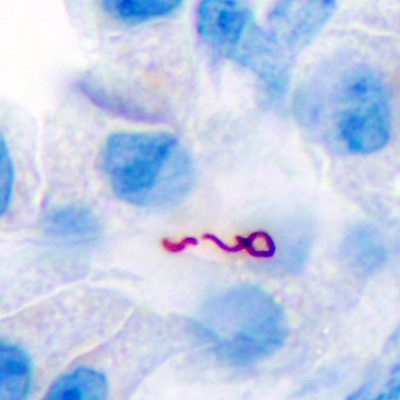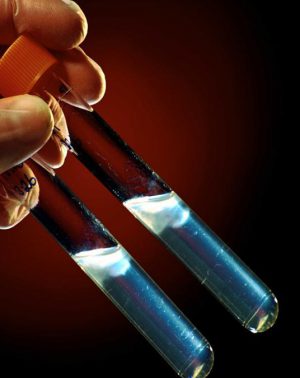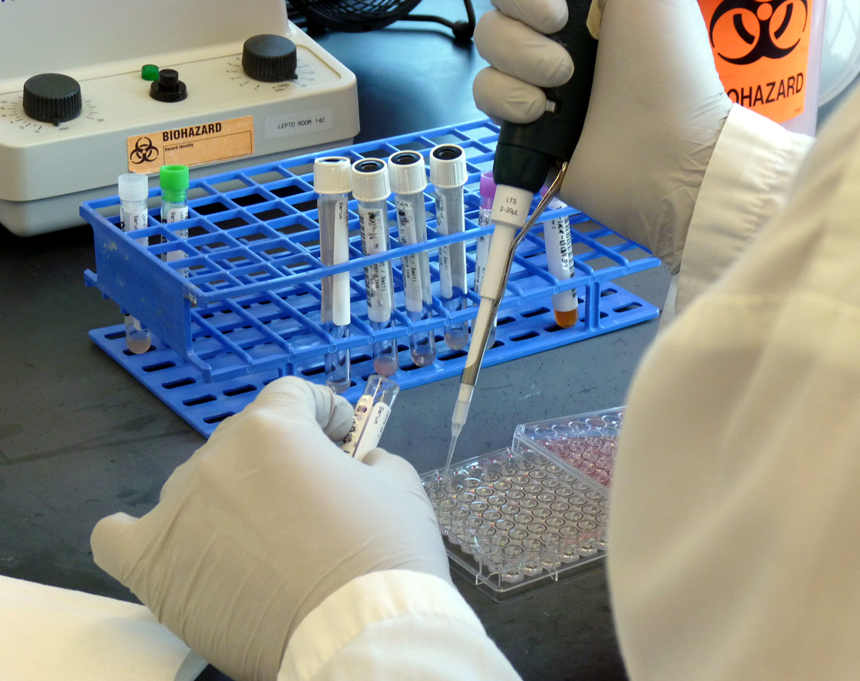When canine leptospirosis is on the differential diagnosis list both clinicians and dog owners want quick and accurate testing. Dogs infected with leptospirosis are at serious risk for hepatic and renal disease, and death. As a zoonotic disease, the potential risk to family members and clinic staff is an additional concern.
Leptospirosis is a disease caused by infection with one of the more than 250 types of bacteria in the genus Leptospira. These bacteria live in warm, wet environments such as damp grass, standing water, mud, and lakes. Under ideal conditions, the bacteria can survive more than three months outside the body. Leptospires are excreted through the urine of infected animals and disease transmission most often occurs through mucous-membrane contact with the urine of infected animals or contaminated food, bedding, soil, or water. Dogs can also be infected from close contact with another infected dog, and through the bite of, or by eating, an infected animal. Raccoons, skunks, opossums, rats, cows, and pigs are all known carriers of the infection.
Leptospirosis in dogs can cause a broad range of clinical signs in any combination. The most common early indicators of Leptospira infection are: anorexia; polyuria, oliguria, or anuria; lethargy; vomiting; diarrhea; and abdominal pain. Even with prompt, exhaustive medical care, 10 to 15 percent of infected dogs may die. Untreated, many infected dogs die of kidney or liver failure.
Wet fall conditions, including flooding, can provide ideal conditions for Leptospira bacteria and the risk of infection for unvaccinated dogs increases.


Diagnostic Options

The gold standard for diagnosis of leptospirosis is a positive culture. However, culturing this bacterium is rarely attempted in diagnostic laboratories because of the difficulty and time it takes for a successful isolation.
Serology has long been the mainstay of leptospirosis diagnostics.
The Bacteriology Laboratory at the MSU VDL conducts over 80,000 serologic assays for leptospirosis annually and performs the Microscopic Agglutination Test (MAT) daily, Monday through Friday. Because the test is performed daily, results are usually reported the same day samples are received—samples received later in the day will be reported the following day. Our canine leptospiral MAT (test code 95055) includes antibody titers against the following six leptospiral serovars: Bratislava, Canicola, Grippotyphosa, Hardjo, Icterohaemorrhagiae, and Pomona. Titers against serovar Autumnalis are available in our expanded panel (test code 95066) or as an add-on (test code 95054) by request.
The prevalence of serovars has changed over the last few decades and is influenced by geography and exposure to reservoir hosts. Currently, the most prevalent serovars are thought to be Grippotyphosa, Icterohaemorrhagiae, Pomona, and Bratislava.
An interpretation is included in each MAT report at no extra charge and additional consultation is also available. As with other serology assays, vaccination complicates the interpretation of titers. Therefore, please provide a leptospiral vaccination history if it is available. This vaccination history is used
in combination with the appropriate clinical history and test request on the submission form to ensure the appropriate tests are requested, and to provide context for the interpretation. For example, please indicate on the submission form if the dog is ill (test is for clinical purposes) or if the test is being requested as part of a vaccine screen (test code 95996) to determine whether the dog needs to be given a booster dose of lepto vaccine.
In a clinical case, performing a PCR assay can detect the leptospiral DNA. The PCR assay (test code 95053) is a quick test with a two to five day turnaround time for a diagnosis. However, due to the transient bacteremic phase of the disease, leptospira will not be detected by PCR in blood after the first few days of infection. Urinary shedding of leptospires is a sequelae of the disease; however, the bacteria may not be present (detected by PCR) in the urine of infected dogs until about five to seven days after they become ill. Antibiotic treatment will also negatively affect the chances of finding leptospires in urine using any method.
Testing with one sample/assay for leptospirosis is not ideal and a combination of serology and organism detection is recommended.
To provide our companion animal (and zoo animal) clients a more complete diagnostic package, we have combined the traditional leptospira serology assay (MAT) with PCR. The MSU VDL’s new leptospirosis panel (test code 95068) includes PCR (blood or urine) and MAT at a discounted price.

Sample Types and Requirements
Remember that antibiotics will negatively impact the detection of leptospires. Please collect urine and blood samples for PCR PRIOR TO beginning antibiotic treatment.
PCR:
- 1 mL of whole blood or 5-10mL of urine
- Ship samples on ice
- Samples should reach the lab within 24-48hr post collection; we recommend using the MSU VDL insulated mailer with UPS overnight return shipping
MAT:
- 0.5 mL of serum or plasma
- Refrigerate sample until shipment
- During hot months, we recommend shipping with an ice pack using the MSU VDL insulated mailer with UPS overnight return shipping
- Separated serum that has been stored ≤ 10° C may be tested up to 1 month post collection
MAT & PCR:
- 0.5 ml serum (or plasma) for MAT AND 5-10 mL urine (or 1 mL whole blood) for PCR
- Ship overnight with an ice pack; we recommend using the MSU VDL insulated mailer with UPS overnight return shipping
For More Information
For more detail please see the MSU VDL catalog of available tests or call 517.353.1683.
To aid clinicians in discussions with dog owners, we also offer a client education guide, “Leptospirosis: What Every Dog Owner Should Know” which is available under Client Education. This guide can be printed or shared with clients electronically. Please contact us if you would like printed copies sent to your clinic.
References:
Lunn, Katharine F. “Leptospirosis in Dogs,” Merck Veterinary Manual. https://www.merckvetmanual.com...
Stokes J.E. et al. (2007) “Prevalence of serum antibodies against six Leptospira serovars in helathy dogs. J Am Vet Med Assoc 230 (11):1657-1664
